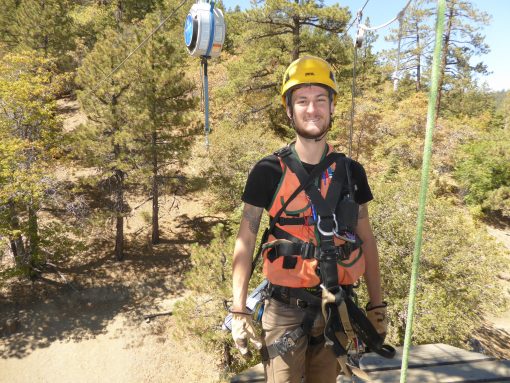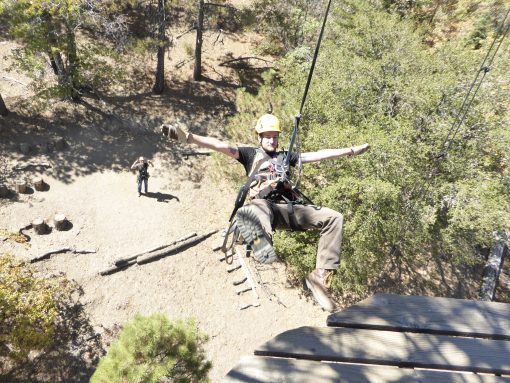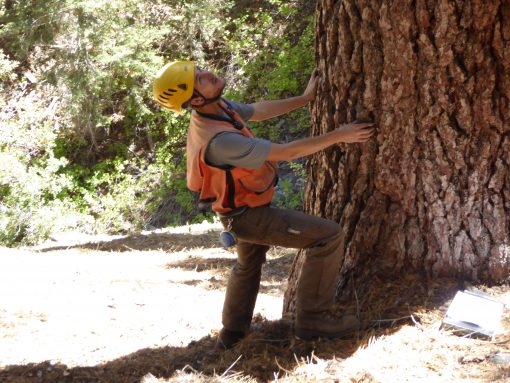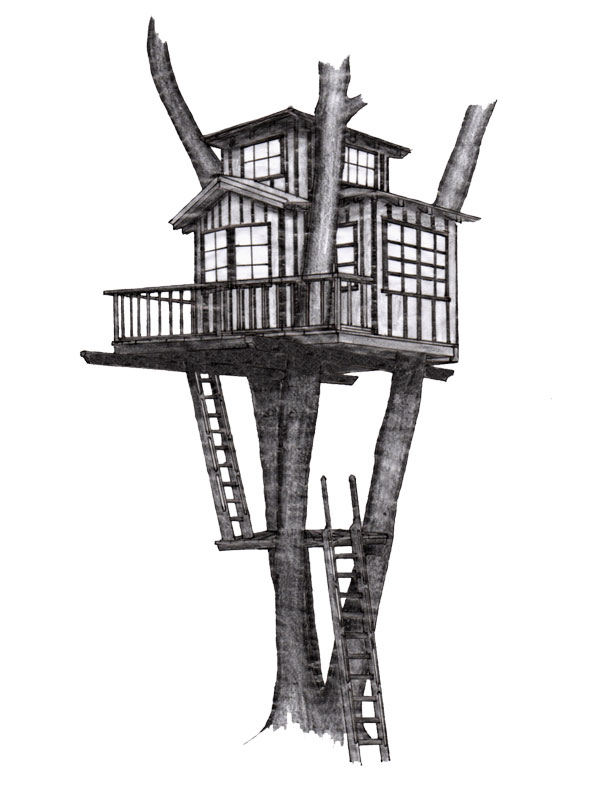
FAQ 5# – Infos all around the treehouseTREE
Today’s FAQ-episode commits oneself to the foundation of every treehouse: the tree. Simultaneously this post is our first guest contribution, written by awesome arborist Casey Clapp, whom we met at the treehouse conference:
“Hello friends! My name is Casey Clapp, I’m a consulting arborist based out of Portland, Oregon, USA. My company, Tree Solutions, Inc., has been working with builders and designers of treehouses, zip lines, and canopy tours (among numerous other sorts of ground-based structures) for over 20 years.
I was lucky enough to get on board and work with the crew over here a few years ago and immerse myself in tree house culture. Now, as an arborist, I am in love with being in and around trees. However, also as an arborist, I am acutely aware of the impacts associated with tree supported structures and how they affect the trees themselves.
As the treehouseblog has noted before, the first and most important thing that one must consider when starting a treehouse project is the tree! So, here are some answers to common questions for you to consider when starting your next treehouse project. (PS: Have fun, and send photos!)
1. What’s the best tree for a treehouse?
This is sort of tricky question for a few reasons. A: some species of trees are better than others for tree supported structures; B: some individual trees, of a good species or not, may not be suitable for any number of reasons. I’ll address A first.
A. Trees have grown and adapted to conditions over millions of years, and have employed different strategies to compete with their fellow trees. Some grow fast and live short lives before decay begins to set in. These trees many times focus their energies on fast growth, and less on compartmentalizing decay agents or building robust structures. Similar to the fabled hare, they focus on getting up and spreading their seed as fast as possible.
On the other hand, some trees grow a bit slower, put more energy into keeping decay out, and building a structure that can last a long time. The second kind of tree is the one you want to aim for. Every time you drill into a tree for a support component, you wound the tree by disrupting the cambium layer (the ‘vascular’ system of the tree, located just beneath the bark). The tree responds to this wound by quarantining the area in a process called compartmentalization.
Trees that are good compartmentalizers, or those that have natural decay resistance in their wood, tend to be better choices for tree supported structures. Trees that don’t compartmentalize well tend to develop decay around the wounds (i.e. where your supports are connected to the tree, which is not good), or can develop central decay columns, and reduce the lifetime of your structure.
Trees species like most oaks, Douglas-fir, hickories, several species of pine, and many true and false cedars tend to be good choices. Species like willow, alder, lime or linden, and poplars tend to be less good choices.
B. The structure of individual trees matters a lot. Even if you get a good species (say, common or English oak, Quercus robur), its form may make it unsuitable. If there is decay present in stem or limbs, if it’s been heavily topped or coppiced, or if it’s too small, it may not be able to last with a heavy house in it. You want to inspect the tree for intense leans, included bark in a co-dominant union, cracks or cavities in the stem, as well as general health and vigor. This can be complicated, so I recommend finding a qualified arborist in your area to give the tree a good once-over to make sure that your $30,000 investment is being built on a health, stable foundation.
2. What do I need to know about the tree?
You’re going to want to know, first and foremost, what the species is. This can help you learn about the species characteristics. For instance, if you know the species, you’ll know if it compartmentalizes decay well, if it is generally short lived, if it develops issues later in life, if it has strong wood, and lots more.
Second, you’re going to want to know how trees grow, live, and die. Trees are amazingly resourceful, and they respond to stimuli in their environment, weather that’s a tree nearby falling and creating more light, or if it’s a person drilling into it. By understanding these processes, you can work with them and not against them.
For example: trees’ cambium layer (again, the ‘vascular’ system of the tree, located just beneath the bark) is the life blood of the tree. This transports nutrients and water up from the ground, and sugars and starches down from the leaves. When this is disrupted or completed blocked off, it’s the equivalent of strangling the tree, or cutting off a portion of its blood supply. Understanding this, and limiting the number of holes in the tree, and making sure that as the tree expands it won’t girdle itself on your treehouse, is extremely important.
3. How do I protect the tree in the building phase?
The building phase is when you are most likely to kill your tree. First thing to remember is that trees work on timelines that are much longer than our own. So, something that causes stress or injures the tree today, may not be noticeable in the tree’s health condition for years. And once it is noticed years later, many times it’s far too late. A few tips to remember when building your house:
Protect the roots!
Those hidden parts are the most important for the tree’s health. Consider this: for many species, if you cut a tree down, it’ll re-sprout from the base and keep going. But, if you take the whole tree that you just cut down and plant it, it will quickly die. This is because the roots support the tree’s life with water and nutrients, and is where sugars and starches are stored for later use. Protect these, and likely your tree will survive the process.
Main thing: avoid compaction of the soil. Before starting any construction, place woodchips mulch around the base of the tree anywhere that will be an access point to the stem, and don’t let anything or anyone go outside that area. Put 4 to 6 inches of it down. I often recommend that plywood be laid out on top of the mulch to further distribute the weight of people and materials.
Remember that roots are growing right in the top 1 to 2 feet of soil, and compaction will reduce the roots’ ability to get nutrients, water, and oxygen, all necessary things for root health and tree health. If you don’t protect the roots, you’ll have a beautiful structure in an extremely stressed tree, which would lead to tree death in the extreme case, or a very long recovery.
Protect the bark!
That cambium layer is the tree’s life line. It connects every root to every leaf, and all the stem tissues in between. When that gets disrupted, the tree is set back. This means put as few holes in the tree as possible. In this case, for tree health, less is more. When installing the structure, take care to not bang the stem and put in wounds. I frequently recommend wrapping the tree’s stem and main limbs with planks of wood or thick fabric during the building process to limit the bark disturbance from machines or build components bumping into the stem.
Don’t remove too many limbs!
Remember that the leaves are the tree’s food producers. Every time you remove a limb, you remove some of the tree’s ability to feed itself. Since you’re putting a huge amount of weight in the tree, and putting wounds in its stem, and likely removing some limbs, the needs all the energy it can make to re-enforce wounded areas, fight decay, and bolster its ability to keep itself standing with such a new and sudden load in its canopy.
4. What can I do to keep my treehouse tree healthy?
Best thing to do is consider the tree first in your design and construction processes. The tree can and will take care of itself whether there’s a treehouse in it or not. This really goes back to protecting the tree during the building process and understanding how it functions. A tree needs non-compacted soils, nutrients, water, oxygen, and light to function best. It comes down to protecting the tree’s growing space.
Disturb as little of the soil area beneath the tree as possible, and where it is disturbed, use woodchip mulch to limit the compaction and give the soil a bit of compostable material to get some extra nutrients.
Drill into the tree as few times as possible.
Make sure that you account for the tree’s future growth. Trees put on new growth rings every year and expand out radially. So, make sure that when the tree inevitably grows out and begins to conflict with the structure that you are able to adjust the building to allow for the growth. If you don’t design in adjustability, you’ll end up girdling the tree and causing significant growth defects, or the tree will slowly compromise the structural integrity of the building by pushing it apart, or, more likely, both.
5. Which book about trees would you recommend me for a start?
First, I would recommend reading The Body Language of Trees or Stupsi Explains the Tree: A Hedgehog Teaches the Body Language of Trees, both by Claus Mattheck. These books do a great job of explaining how trees work and what to look for when assessing a tree for health and structure.
Next, I highly recommend reading The Tree, by Colin Tudge. This book is already recommended on the treehouseblog, and for good reason. This book explains how trees work and gives the reader an idea of just how incredible these organisms are. If you don’t respect trees and their way of life now, after reading The Tree, you certainly will.
From a tree standpoint, these are the books to get you started. An understanding of trees and how they function will set you off on the right foot for your build.



Photos by courtesy of Casey Clapp

[…] Use preferably natural materials to treat the tree and his environment with care. Look at our FAQ #5 for further information. DON’T: Don’t take your laptop, tablet, mobile phone up to the trees. […]